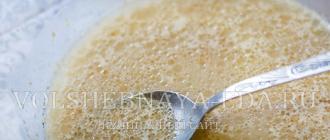In the last video lesson we looked at solving problems involving percentages using proportions. Then, according to the conditions of the problem, we needed to find the value of one or another quantity.
This time the initial and final values have already been given to us. Therefore, the problems will require you to find percentages. More precisely, by how many percent has this or that value changed. Let's try it.
Task. The sneakers cost 3,200 rubles. After the price increase, they began to cost 4,000 rubles. By what percentage was the price of sneakers increased?
So, we solve through proportion. The first step - the original price was 3,200 rubles. Therefore, 3200 rubles is 100%.
In addition, we were given the final price - 4000 rubles. This is an unknown percentage, so let's call it x. We get the following construction:
3200 — 100%
4000 - x%
Well, the condition of the problem is written down. Let's make a proportion:
The fraction on the left cancels perfectly by 100: 3200: 100 = 32; 4000: 100 = 40. Alternatively, you can shorten it by 4: 32: 4 = 8; 40: 4 = 10. We get the following proportion:

Let's use the basic property of proportion: the product of the extreme terms is equal to the product of the middle terms. We get:
8 x = 100 10;
8x = 1000.
This is common linear equation. From here we find x:
x = 1000: 8 = 125
So, we got the final percentage x = 125. But is the number 125 a solution to the problem? No, under no circumstances! Because the task requires finding out by how many percent the price of sneakers was increased.
By what percentage - this means we need to find the change:
∆ = 125 − 100 = 25
We received 25% - that’s how much the original price was increased. This is the answer: 25.
Problem B2 on percentages No. 2
Let's move on to the second task.
Task. The shirt cost 1800 rubles. After the price was reduced, it began to cost 1,530 rubles. By what percentage was the price of the shirt reduced?
We translate the condition to mathematical language. The original price is 1800 rubles - this is 100%. And the final price is 1,530 rubles - we know it, but we don’t know what percentage it is of the original value. Therefore, we denote it by x. We get the following construction:
1800 — 100%
1530 - x%
Based on the received record, we create a proportion:
![]()
To simplify further calculations, let's divide both sides of this equation by 100. In other words, we will cross out two zeros from the numerator of the left and right fractions. We get:
Now let's use the basic property of proportion again: the product of the extreme terms is equal to the product of the middle terms.
18 x = 1530 1;
18x = 1530.
All that remains is to find x:
x = 1530: 18 = (765 2) : (9 2) = 765: 9 = (720 + 45) : 9 = 720: 9 + 45: 9 = 80 + 5 = 85
We got that x = 85. But, as in the previous problem, this number in itself is not the answer. Let's go back to our condition. Now we know that the new price obtained after the reduction is 85% of the old one. And in order to find changes, you need from the old price, i.e. 100%, subtract the new price, i.e. 85%. We get:
∆ = 100 − 85 = 15
This number will be the answer: Please note: exactly 15, and in no case 85. That's all! The problem is solved.
Attentive students will probably ask: why in the first problem did we subtract from finite number initial, and in the second problem they did exactly the opposite: subtracted the final 85% from the initial 100%?
Let's be clear on this point. Formally, in mathematics, a change in a quantity is always the difference between the final value and the initial value. In other words, in the second problem we should have gotten not 15, but −15.
However, this minus should under no circumstances be included in the answer, because it is already taken into account in the conditions of the original problem. It says directly about the price reduction. And a price reduction of 15% is the same as a price increase of −15%. That is why in the solution and answer to the problem it is enough to simply write 15 - without any minuses.
That's it, I hope we have sorted this out. This concludes our lesson for today. See you again!
The concept of percentage comes up too often in our lives, so it is very important to know how to solve problems involving percentages. In principle, this is not a difficult matter, the main thing is to understand the principle of working with interest.
What is percentage
We operate with the concept of 100 percent, and accordingly, one percent is a hundredth of a certain number. And all calculations are carried out based on this ratio.
For example, 1% of 50 is 0.5, 15 of 700 is 7.
How to decide
- Knowing that one percent is one hundredth of the number presented, you can find any number of percentages required. To make it more clear, let's try to find 6 percent of the number 800. This is done simply.
- First we find one percent. To do this, divide 800 by 100. It turns out 8.
- Now we multiply this same one percent, that is, 8, by the number of percent we need, that is, by 6. It turns out 48.
- Let's consolidate the result by repeating it.
15% of 150. Solution: 150/100*15=22.
28% of 1582. Solution: 1582/100*28=442.
- There are other problems where you are given quantities and you need to find the percentages. For example, you know that the store has 5 scarlet roses out of 75 white ones, and you need to find out what the percentage is scarlet. If we don’t know this percentage, then we’ll designate it as x.
There is a formula for this: 75 – 100%
In this formula, the numbers are multiplied cross by cross, that is, x=5*100/75. It turns out that x = 6% So the percentage of scarlet roses is 6%.
- There is another type of percentage problem where you need to find how many percent one number is greater or less than another. How to solve problems with percentages in this case?
There are 30 people in the class, 16 of them are boys. The question is, what percentage are there more boys than girls? First you need to calculate what percentage of students are boys, then you need to find out what percentage are girls. And in the end, find the difference.
So let's get started. We make a proportion of 30 units. – 100%
16 lessons -X %
Now we count. X=16*100/30, x=53.4% of all students in the class are boys.
Now let's find the percentage of girls in the same class. 100-53.4=46.6%
Now all that remains is to find the difference. 53.4-46.6=6.8%. Answer: there are more boys than girls by 6.8%.
Key points in solving percentages
So, so that you don't have any problems with how to solve percentage problems, remember a few basic rules:
- To avoid getting confused in percentage problems, always be vigilant: move from specific values to percentages and vice versa, if necessary. The main thing is to never confuse one with the other.
- Be careful when calculating percentages. It is important to know from what specific value you need to count. For successive changes in values, the percentage is calculated from the last value.
- Before writing down the answer, read the entire problem again, because it may be that you have found only an intermediate answer, and you need to perform one or two more actions.
Thus, solving problems with percentages is not such a difficult matter, the main thing in it is attentiveness and accuracy, as indeed in all mathematics. And don't forget that to improve any skill, practice is necessary. So decide more, and everything will be fine or even great.
A percentage is a type of decimal fraction. The essence of percentage can be understood from the name, which comes from the word “cento”, which means “hundred”. It follows that a percentage is a hundredth of a whole number, taken as one. The % sign is used to denote percentages in mathematics and other fields of science.Does the average person need this?
Of course, most often, people whose activities are related to science have to deal with interest. It is not uncommon that this happiness goes to students within school curriculum mathematics. However, the scope of interest is so wide that representatives of a wide variety of professions and occupations are faced with the need to calculate them. The audience of our site is no exception. After all, summer residents are often faced with the task of determining the concentration of a fertilizer solution, calculating the tax on land or other property, determining the size of the loan payment, etc.
In all these cases, you cannot do without the ability to correctly handle interest. But they are capricious comrades, they don’t like mistakes. Therefore, despite the apparent simplicity of problems with percentages, when solving them it is necessary to observe a number of rules: certain rules.
Basic technique
All problems that involve percentages can be solved quite simply by using the principle of proportion. What is its essence? For example, you need to determine what 76% of the number 840 is? For this, an appropriate proportion is drawn up. In it, 840 is equal to 100%. The desired value of x is 76%. This allows us to create the following ratio:
840 / x = 100% / 76% or 840 * 76% = x * 100%
It turns out that:
x = 840*76% / 100% = 638.4
As you can see, everything is extremely simple.
Basic types of problems with percentages
From a mathematical point of view, we can distinguish 3 categories of problems, the solution of which involves calculating percentages.
First type
This is when you need to find the percentage of a specific number specified in the conditions. Adapting the example to the circumstances of life of summer residents, we can give the following task. Let us assume that, according to the laws of a certain region, the owner of a private land plot must pay land tax annually. Its size is determined as 2% of the cadastral value of the land. The price of the plot is 327 thousand rubles. What is the annual tax amount? To answer the question posed, a proportion is drawn up:
327 thousand rubles. = 100%;
X thousand rub. = 2%.
Bringing this dependence to the equation, we get: x * 100 = 327 * 2. As a result: x = 327 * 2/100 = 6.54 thousand rubles.
Another example of this kind of problem is related to an issue that worries the vast majority of summer residents - increases in pensions or wages. Let’s assume that a person’s pension is now 7,200 rubles, but starting next month they promise to increase it by 15%. How much will it be directly in rubles? Again the proportion is drawn up:
Second type
In this case, you have to solve the inverse problem, that is, calculate the number using the existing percentage. For example, it is known that 10 kg of a certain substance are included in the fertilizer, while representing 40% of its total amount. It is necessary to determine the total mass of the finished fertilizer. For this, a proportion is also drawn up, but it will look a little different:
10 kg – 40%
x kg – 100%
It follows that x = 10 * 100 / 40 = 25 kg.
Third type
This category includes problems in which you need to determine in one number percentage another. For example, the volume of morning watering of carrots should be 60 liters. In the evening you need to pour 150 liters onto the beds. What percentage of evening watering is morning watering? The basic relationship is as follows:
150 l – 100%;
60 l cup – x %
Then: x = 60*100/ 150 = 40%
For those summer residents who are considering their personal plot, as a source of income, the technology for calculating profitability should be interesting. This indicator is used in economics as a measure of the success of an enterprise and is also calculated as a percentage. It is by the level of profitability that one judges how rationally the production process is organized.
So, the calculation is based on two quantities:
* full cost, including all cash expenses, including transport, as well as the purchase of equipment, etc.;
* income received from sales harvested.
Their difference represents net profit. Pr = D – S. In this case, the profitability formula has the form: P = Pr/S*100%. Thus, if the total cost of production is 8,200 rubles, and it was sold for 9,000 rubles, the profitability will be equal to: P = (9,000 – 8,200)/8,200 * 100% = 9.75%. Typically, 5% is considered an acceptable level of profitability in the economics of an enterprise. If the indicators are lower, management is advised to look for options for more rational organization labor.
In any case, you need to know how to solve algebra problems with percentages in school, and then later it will not be difficult for you.
Peter, www.site
For solving most problems in mathematics high school Knowledge of drawing up proportions is required. This simple skill will help you not only perform complex exercises from the textbook, but also delve into the very essence of mathematical science. How to make a proportion? Let's figure it out now.
The most simple example is a problem where three parameters are known, and the fourth needs to be found. The proportions are, of course, different, but often you need to find some number using percentages. For example, the boy had ten apples in total. He gave the fourth part to his mother. How many apples does the boy have left? This is the simplest example that will allow you to create a proportion. The main thing is to do this. Initially there were ten apples. Let it be 100%. We marked all his apples. He gave one-fourth. 1/4=25/100. This means he has left: 100% (it was originally) - 25% (he gave) = 75%. This figure shows the percentage of the amount of fruit remaining compared to the amount initially available. Now we have three numbers by which we can already solve the proportion. 10 apples - 100%, X apples - 75%, where x is the required amount of fruit. How to make a proportion? You need to understand what it is. Mathematically it looks like this. The equal sign is placed for your understanding.

10 apples = 100%;
x apples = 75%.
It turns out that 10/x = 100%/75. This is the main property of proportions. After all, the larger x, the greater the percentage of this number from the original. We solve this proportion and find that x = 7.5 apples. We do not know why the boy decided to give away an integer amount. Now you know how to make a proportion. The main thing is to find two relationships, one of which contains the unknown unknown.
Solving a proportion often comes down to simple multiplication and then division. Schools do not explain to children why this is so. Although it is important to understand that proportional relationships are mathematical classics, the very essence of science. To solve proportions, you need to be able to handle fractions. For example, it is often necessary to convert interest into common fractions. That is, recording 95% will not work. And if you immediately write 95/100, then you can make significant reductions without starting the main calculation. It’s worth saying right away that if your proportion turns out to be with two unknowns, then it cannot be solved. No professor will help you here. And your task most likely has a more complex algorithm for correct actions.

Let's look at another example where there are no percentages. A motorist bought 5 liters of gasoline for 150 rubles. He thought about how much he would pay for 30 liters of fuel. To solve this problem, let's denote by x the required amount of money. You can solve this problem yourself and then check the answer. If you have not yet understood how to make a proportion, then take a look. 5 liters of gasoline is 150 rubles. As in the first example, we write down 5l - 150r. Now let's find the third number. Of course, this is 30 liters. Agree that a pair of 30 l - x rubles is appropriate in this situation. Let's move on to mathematical language.
5 liters - 150 rubles;
30 liters - x rubles;
Let's solve this proportion:
x = 900 rubles.
So we decided. In your task, do not forget to check the adequacy of the answer. It happens that when wrong decision cars reach unreal speeds of 5000 kilometers per hour and so on. Now you know how to make a proportion. You can also solve it. As you can see, there is nothing complicated about this.
Problems involving percentages first appear in the lives of young mathematicians in the 5th grade and accompany them until their final exams. Interest-related tasks can be found in Unified State Exam options(in particular, task No. 17 of the profile exam) and the OGE. Percentages will inevitably appear in courses in physics, chemistry, and economics. In the end, in everyday life We come across this concept all the time (think, for example, of loan rates or generous promises of 90% discounts in stores).
In this article we will start with the simplest definitions and examples, we will gradually increase the level of complexity and by the 4th part we will get to quite difficult problems.
Interest. Initial information.
How to find the percentage of a number
Surprisingly, many graduates cannot clearly explain what percent. But everything is very simple:
Percent is the hundredth part of the number.
Why exactly the hundredth? Yes, simply because it is convenient to divide by 100 and a hundred is not too much and not too little (not a very strict definition).
To find 1% of a number, you simply divide that number by 100.
Example 1. Find 1% of 1200, 1% of 2, 1% of 98765.
1% of 1200 is 12, because 1200:100 = 12;
1% of 2 is 0.02, because 2:100 = 0.02;
1% of 98765 = 98765:100 = 987.65.
Task 1. Calculate 1% of 450, 1% of 12000, 1% of 9.
Task 2. Calculate 1% of 1% of 6700.
How to find a few percent of a number
Now suppose that we need to find not 1% of the number, but, say, 12%. How to do this? You can, of course, first find one percent, and then multiply the resulting result by 12. But why perform two actions if you can do with one? One percent is one hundredth, and t percent is t hundredths. To find, for example, 12 hundredths of a number, you need to multiply the number by 0.12. We get a universal rule:
To find t% of a number, you need to multiply this number by t 100.
t percent of A = A ⋅ t 100
Example 2. Find 17% of 300, 86% of 20, 140% of 2, 0.1% of 4000.
17% of 300 is 51, because 300 * 0.17 = 51 (multiply the number by seventeen hundredths);
86% of 20 is 17.2, because 20*0.86 = 17.2 (multiply by 86/100);
140% of 2 = 2*1.4 = 2.8 (1.4 is just 140/100);
0.1% of 4000 = 0.001*4000 = 4 (0.001 is 0.1/100).
Task 3. Calculate 14% of 1200, 57% of 50, 250% of 4, 0.02% of 1000000.
Example 3. Calculate 18% of 80% of 1000. Is this really the same as 98% of 1000?
Let's first find 80% of 1000: 1000*0.8 = 800.
We are looking for 18% of the resulting number: 800*0.18 = 144.
Now let's find 98% of 1000. Multiply 1000 by 98/100 and get 980.
As you can see, the results were different.
Task 4. Calculate 120% of 40% of 350.
How to find "percentage of interest"
What if we need to calculate a long sequence of "percentages of percentages"? Let's say, 10% of 10% of 10% of 10% of 200. You can, of course, act sequentially and break the task into 4 actions, but there is an easier way.
Example 4. Calculate 20% of 30% of 40% of 10,000.
Why perform multiple sequential multiplications when everything can be reduced to one line:
0,2*0,3*0,4*10000 = 24.
See how simple it is! By the way, no parentheses are needed in this case.
Task 5. Calculate 50% of 50% of 40% of 2000.
Task 6. In the first week of January, 40% of the monthly norm of snow (90 mm) fell, with 90% of this amount falling on Wednesday, with 70% of the precipitation falling in the first half of that day. How many mm of snow fell on Wednesday morning?
So, let's summarize some results:
- A percentage is one hundredth of a number.
- To calculate 1%, divide the number by 100 (or multiply by 0.01).
- To find t% of a number, you need to multiply the number by t hundredths.
A short test on the topic "Percentages"
Take a couple of minutes and take a short test on the topic "Percentages". Please indicate an integer or decimal. Always use a comma as a decimal separator (for example, 1.2, but not 1.2!) Good luck!






